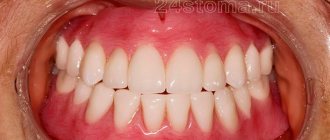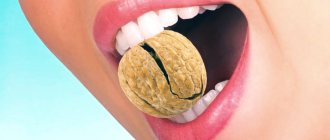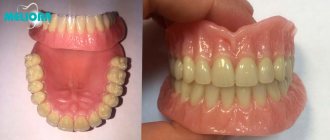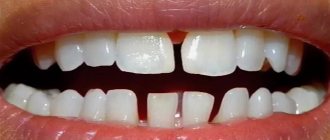Normally, there should be some transparency of the tooth enamel. Moreover, it varies in different zones. There are teeth with high, medium and low degrees of transparency, and dentists take this into account when selecting materials for restoration.
But the protective layer can become thinner and destroyed under the influence of microorganisms, acids and other negative factors. Then the transparency of the tooth enamel increases and becomes pathological.
Teeth with such changes are characterized by:
- increased fragility;
- chips;
- the appearance of cracks;
- sensitivity to sweet, sour, hot and cold;
- vulnerability to caries, periodontitis, and the appearance of neoplasms.
What to do if your teeth become transparent? Causes of thinning enamel and ways to restore it
When there are no signs of a pathological process and the integrity of the crowns is not compromised, and the teeth have become transparent, there is a reason to consult a specialist. There are many reasons for this phenomenon, and it is impossible to do without professional diagnostics. As a rule, such an anomaly indicates severe thinning of the enamel. Often in such cases, hyperesthesia occurs, that is, increased sensitivity. So why do teeth become transparent and what to do about it - read more about this later in this article.
Transparency of enamel - when is it normal and when is it pathological?
In normal condition, the tips of the front teeth - their cutting edges - remain slightly translucent, which is explained by the absence of dentin in these areas. With age, the degree of transparency may increase, which is associated with the gradual abrasion of the enamel, literally its wear and thinning. This is a normal process from a physiological point of view.
It’s another matter if the crowns acquired an unhealthy shine and became almost glassy for no apparent reason. Against the background of pathological thinning of the enamel layer, dentin begins to noticeably show through, which may have a yellowish, grayish or brown tint. A picture like this requires urgent medical attention.
If a child’s baby teeth become transparent up to the middle of the crowns, this may indicate the development of a pathological condition such as hypoplasia. In other cases, the symptom indicates increased abrasion of the enamel, which today occurs to one degree or another in approximately 12% of adults. At an advanced stage, it leads to dentin exposure, the appearance of serious aesthetic defects, the development of carious processes and tooth destruction.
Transparent teeth in a child may indicate a problem
Damage area
It is very rare for a tooth to become completely transparent.
If the teeth are clear at the ends or at the cutting part, then this is not a serious problem. In every person, the enamel in this place is thinner, and dentin is completely absent. Therefore, it seems that the cutting edge of the tooth is like glass. Also read: Zirconium veneers: what are they, who are they recommended for? Much more problems are created by fluorosis in the cervix and equator. Despite the fact that in the cervical area the enamel has a thin base, under its layer there is dentin.
Therefore, when the protective coating becomes thinner, the tooth becomes glassy and the yellow-brown color of the dentin appears. This creates the impression that caries has appeared and the enamel is covered with plaque. Due to this, the person is in an uncomfortable state, as he tries to control his smile.
Why does enamel thin and become transparent?
The teeth become transparent at the edges and beyond because the thickness of the enamel layer decreases. Various factors can provoke this phenomenon, and here are the main possible reasons:
- acute deficiency of phosphorus, calcium and fluorine in the body - the cause may be a harmful unbalanced diet and unfavorable environmental conditions in the place of residence,
- the use of inappropriate hygiene products - the thinning of the protective layer on the teeth is often the result of constant exposure to a hard brush and abrasive pastes, or too intense cleaning. All this leads to injury to hard tissues,
- too frequent bleaching - excessive aggressive effects of bleaching components do not go away without leaving a trace,
- abuse of foods high in acids and sugars, carbonated drinks,
- diseases of the stomach and intestines - many of them provoke increased acidity and changes in the pH environment in the oral cavity. Experts include such diseases as gastritis with frequent attacks of heartburn,
- abundant plaque and deposits - do not allow the enamel to be fully saturated with oxygen and create favorable conditions for the rapid proliferation of bacteria, leading to demineralization of the enamel and the development of caries,
- taking antibiotics and other potent medications,
- mechanical injuries – both one-time and permanent.
Too frequent bleaching can cause problems.
It should be noted that smoking can also provoke the development of pathology. Constant exposure to smoke and nicotine tars leads to changes in the structure of dental tissues, causing them to weaken and the enamel to become thinner. Another possible cause is heredity.
Preventing tooth translucency
It is impossible to prevent genetic diseases, but to prevent the progression of tooth transparency, external influences should be kept under control.
Simple measures will help protect tooth enamel:
- proper brushing of teeth (with a medium-hard brush and without strong pressure);
- use whitening toothpastes no more than once a week;
- limiting the consumption of soda, fruit juices, acidic foods and drinks;
- Mandatory rinsing of the mouth with clean water after eating sour and sweet foods.
The transparency of the enamel on the teeth can be reduced by toothpastes with fluoride and mineral supplements, massages to improve blood supply to the teeth and a healthy diet. Include in your diet milk, cottage cheese, natural yoghurts, cheeses, fresh fruits, broccoli, Chinese and white cabbage and other foods rich in vitamin complexes.
What is the danger?
Thinning of the teeth at the ends leads to increased fragility of hard tissues, and then they begin to react sharply to any external stimuli: mechanical, temperature and chemical. Any damage can provoke infection and inflammation of the internal structures of the tooth, leading to the development of diseases such as caries, pulpitis, and periodontitis. In addition, the crowns themselves become weak and risk breaking under the chewing load.
According to statistics, this phenomenon most often occurs in middle-aged patients - from 30 to 50 years old1. At the same time, the pathological process itself is sluggish and can develop over a long period of time – 10-15 years. In the most advanced cases, dentin is exposed in some areas, which not only affects the appearance of the smile, but also causes severe pain.
Teeth become weak and may break
How to fix the problem - what dentistry offers
When answering questions about what to do if teeth have become transparent, and how to correct the defect, it should be noted that modern dentistry has all the necessary capabilities to solve the problem at any stage of its development. However, the sooner you see a doctor, the less money, time and nerves you will have to spend to return everything to the way it was. Below are the main methods that are used to correct such defects.
Fluoridation procedure
Demineralization is one of the main causes of thinning of the upper layer of teeth. To correct the situation, the tissues need to be saturated with useful substances and microelements. To do this, a fluoridation procedure is carried out - the enamel is coated with special fluoride-based preparations. According to reviews from patients and experts, such compositions strengthen hard tissues, restore their protective functions, and also slow down the process of calcium leaching.
Fluoridation will help strengthen your teeth
“I once wanted to buy fluoridated gel, I thought to strengthen my teeth, because at that time I noticed that sensitivity had appeared. It’s good that at the last moment I thought of going to the dentist for advice. The doctor immediately said that the remedy that I chose would not suit me. He prescribed a completely different drug, and before that he also had a procedure for removing plaque and stone. Otherwise, not only there was no effect, but it could have ruined my teeth. So it’s better not to do anything without consulting a specialist.”
Liliya V., from correspondence on the forum www.32top.ru
Remineralization course
Another similar procedure is remineralization. Their main difference with fluoridation is the use of different drugs, but the essence is the same. Remineralizing gels contain not only fluoride, but also useful minerals, vitamins, calcium, phosphorus and magnesium. The dentist selects the product based on the characteristics of each specific clinical picture.
Most often, doctors prescribe remineralization courses - 7-14 procedures. Within each of them, a specialist performs applications with a gel saturated with useful components2. Another option is to carry out the procedures yourself using special mouth guards, but their use must be agreed upon with the attending physician.
The remineralization procedure will help solve the problem.
Enamel implantation
Many people are familiar with the concept of “dental implantation,” but few know that enamel can also be implanted. The procedure is performed when there are obvious signs of demineralization, dentin exposure and hypersensitivity of hard tissues. Specialized products with a synthetic composition, for example, InnoDent, are applied to the surface of the teeth. By the way, this drug from the Junior series is used in pediatric dentistry.
Specialized products with a synthetic composition are applied to the surface of the teeth.
After applying the composition, the processes of natural regeneration of living tissues are launched, that is, the enamel layer and dentin are restored at the molecular level. The course lasts an average of a month, and during this time the teeth return to their original state.
Restoration with light composites
If there is a significant deterioration in the appearance of the smile and other serious problems caused by thinning, the doctor may suggest a more radical solution. In such cases, for example, extensions are carried out with light composites. Using this procedure, you can completely hide demineralized areas, as well as microcracks and chips, and adjust the shade.
Lighting composites will help solve the problem
Installation of veneers or lumineers - microprosthetics
Another possible solution to the problem is the installation of veneers or lumineers. We are talking about thin overlays that are fixed to the teeth using a special adhesive. With their help, you can hide many external defects, including chips, cracks, and traces of non-carious lesions. They also allow you to correct the size and shape of crowns, hide interdental spaces, and make your smile impeccably snow-white.
Veneers can be used in treatment
Replacing damaged teeth with crowns
In advanced cases, when the enamel has worn away too much and the teeth are literally destroyed, the only way out of the situation is prosthetics with artificial crowns. Such single dentures can be made of different materials: from solid metal to metal-ceramics, ceramics and zirconium dioxide. Products are created from impressions in a dental laboratory. The finished prosthesis completely matches the shape and shade of the living crown.
The issue can also be resolved using crowns
Typically, tooth enamel is close to milky white in color.
It is also characterized by translucency. And the color of teeth, which we perceive as the color of enamel, is still determined by the color of dentin, because it is this that shines through the translucent enamel.
In young children, tooth enamel is denser and has a more pronounced relief than in adults. It is for this reason that their teeth look whiter and lighter, since the enamel is less visible. Over time, the enamel becomes thinner and smoother due to its contact with food and drinks, so the enamel becomes even more transparent. And then the natural color of dentin appears through it, which can be yellow, brownish, gray.
One should also take into account the fact that the color itself is uneven in its structure. The closer the dentin is to the edge, the lighter it is, and closer to the root the shade darkens several tones. At the same time, different teeth also have different colors, for example, canines, as a rule, are somewhat darker than the incisors. Even if your teeth become increasingly darker with age, you should not worry: all problems can now be easily solved by aesthetic dentistry . For example, ZOOM laser teeth whitening does an excellent job of returning teeth to their white color, and for those who want to hide some defects in parallel with teeth lightening, there are veneers and lumineers .
You can often hear that dark-skinned people have whiter teeth than light-skinned people. However, this is not quite true. The fact is that the bright whiteness of teeth is partly due to the contrast to dark skin. This is why even if you are slightly tanned, your teeth will appear whiter.
Scientists have repeatedly conducted studies regarding the natural, natural color of teeth in different peoples. The results were not surprising - the shade of enamel and dentin is usually determined genetically and is almost not modified in any way under the influence of external factors. The environment in which a person lives affects the color of teeth to a lesser extent than his heredity.
- Promotion
Dental treatment under anesthesia
Promotion for sedation in Moscow!
If you experience: — Severe stress during dental treatment — Fear of the sound of dental instruments — Time-limited visits to the dentist
old price
12 000 ₽
price
5 900 ₽
Free consultation RUB 5,900 for 30 minutes
Limited offer. Sign up for a free consultation. There are contraindications, consultation with a specialist is required.
- Promotion
Teeth whitening ZOOM
Promotion for teeth whitening in Moscow!
As a gift: - Prof. Oral hygiene – Whitening care set with individual trays
old price
40 000 ₽
price
19 900 ₽
Free consultation Sign up for a free consultation. There are contraindications, consultation with a specialist is required.
When doing prosthetics and dental implantation, the doctor is faced with the task of correctly selecting the shade of the tooth. Of course, the new tooth should not stand out too much in the row, attracting the attention of others. To determine the shade, the so-called Vita scale is used - it is used to create orthopedic structures and to select veneers and lumineers.
The scale itself is a small rail on which samples are attached. These samples are usually made of plastic or metal-ceramic, the latter being considered the best for shade selection as they have the same shine as natural teeth and therefore reflect the color appropriately. The gradation of samples is carried out on a scale from A to D, where the letter A denotes reddish-brown shades, and D – reddish-gray. Next to each letter there is a number from one to four; it indicates the brightness level; the lower the number, the brighter the shade.











